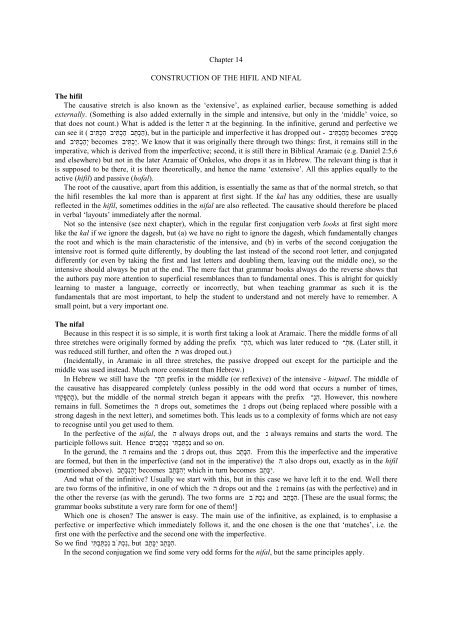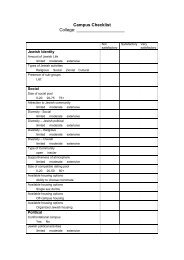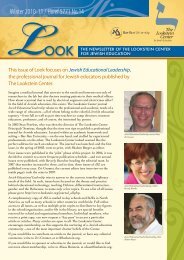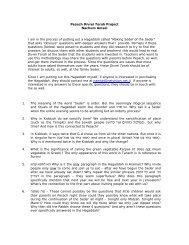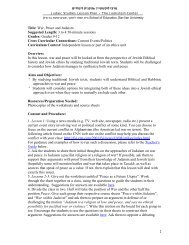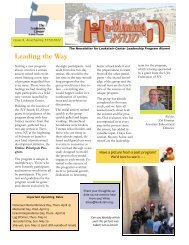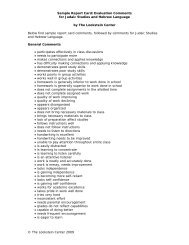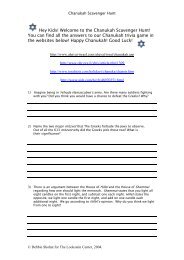FUNDAMENTAL CONCEPTS of the CLASSICAL HEBREW VERB
FUNDAMENTAL CONCEPTS of the CLASSICAL HEBREW VERB
FUNDAMENTAL CONCEPTS of the CLASSICAL HEBREW VERB
Create successful ePaper yourself
Turn your PDF publications into a flip-book with our unique Google optimized e-Paper software.
Chapter 14<br />
CONSTRUCTION OF THE HIFIL AND NIFAL<br />
The hifil<br />
The causative stretch is also known as <strong>the</strong> ‘extensive’, as explained earlier, because something is added<br />
externally. (Something is also added externally in <strong>the</strong> simple and intensive, but only in <strong>the</strong> ‘middle’ voice, so<br />
that does not count.) What is added is <strong>the</strong> letter ה at <strong>the</strong> beginning. In <strong>the</strong> infinitive, gerund and perfective we<br />
מַכְתִּיב becomes מְהַכְתִּיב - out but in <strong>the</strong> participle and imperfective it has dropped ,(הַכְתֵּב הַכְתִּיב הִכְתִּיב ( it can see<br />
and יְהַכְתִּיב becomes .יַכְתִּיב We know that it was originally <strong>the</strong>re through two things: first, it remains still in <strong>the</strong><br />
imperative, which is derived from <strong>the</strong> imperfective; second, it is still <strong>the</strong>re in Biblical Aramaic (e.g. Daniel 2:5,6<br />
and elsewhere) but not in <strong>the</strong> later Aramaic <strong>of</strong> Onkelos, who drops it as in Hebrew. The relevant thing is that it<br />
is supposed to be <strong>the</strong>re, it is <strong>the</strong>re <strong>the</strong>oretically, and hence <strong>the</strong> name ‘extensive’. All this applies equally to <strong>the</strong><br />
active (hifil) and passive (h<strong>of</strong>al).<br />
The root <strong>of</strong> <strong>the</strong> causative, apart from this addition, is essentially <strong>the</strong> same as that <strong>of</strong> <strong>the</strong> normal stretch, so that<br />
<strong>the</strong> hifil resembles <strong>the</strong> kal more than is apparent at first sight. If <strong>the</strong> kal has any oddities, <strong>the</strong>se are usually<br />
reflected in <strong>the</strong> hifil, sometimes oddities in <strong>the</strong> nifal are also reflected. The causative should <strong>the</strong>refore be placed<br />
in verbal ‘layouts’ immediately after <strong>the</strong> normal.<br />
Not so <strong>the</strong> intensive (see next chapter), which in <strong>the</strong> regular first conjugation verb looks at first sight more<br />
like <strong>the</strong> kal if we ignore <strong>the</strong> dagesh, but (a) we have no right to ignore <strong>the</strong> dagesh, which fundamentally changes<br />
<strong>the</strong> root and which is <strong>the</strong> main characteristic <strong>of</strong> <strong>the</strong> intensive, and (b) in verbs <strong>of</strong> <strong>the</strong> second conjugation <strong>the</strong><br />
intensive root is formed quite differently, by doubling <strong>the</strong> last instead <strong>of</strong> <strong>the</strong> second root letter, and conjugated<br />
differently (or even by taking <strong>the</strong> first and last letters and doubling <strong>the</strong>m, leaving out <strong>the</strong> middle one), so <strong>the</strong><br />
intensive should always be put at <strong>the</strong> end. The mere fact that grammar books always do <strong>the</strong> reverse shows that<br />
<strong>the</strong> authors pay more attention to superficial resemblances than to fundamental ones. This is alright for quickly<br />
learning to master a language, correctly or incorrectly, but when teaching grammar as such it is <strong>the</strong><br />
fundamentals that are most important, to help <strong>the</strong> student to understand and not merely have to remember. A<br />
small point, but a very important one.<br />
The nifal<br />
Because in this respect it is so simple, it is worth first taking a look at Aramaic. There <strong>the</strong> middle forms <strong>of</strong> all<br />
three stretches were originally formed by adding <strong>the</strong> prefix ,הִתְ־ which was later reduced to .אִתְ־ (Later still, it<br />
was reduced still fur<strong>the</strong>r, and <strong>of</strong>ten <strong>the</strong> ת was droped out.)<br />
(Incidentally, in Aramaic in all three stretches, <strong>the</strong> passive dropped out except for <strong>the</strong> participle and <strong>the</strong><br />
middle was used instead. Much more consistent than Hebrew.)<br />
In Hebrew we still have <strong>the</strong> הִתְ־ prefix in <strong>the</strong> middle (or reflexive) <strong>of</strong> <strong>the</strong> intensive - hitpael. The middle <strong>of</strong><br />
<strong>the</strong> causative has disappeared completely (unless possibly in <strong>the</strong> odd word that occurs a number <strong>of</strong> times,<br />
However, this nowhere .הִנְ־ but <strong>the</strong> middle <strong>of</strong> <strong>the</strong> normal stretch began it appears with <strong>the</strong> prefix ,(הָתְפָּקְדוּ<br />
remains in full. Sometimes <strong>the</strong> ה drops out, sometimes <strong>the</strong> נ drops out (being replaced where possible with a<br />
strong dagesh in <strong>the</strong> next letter), and sometimes both. This leads us to a complexity <strong>of</strong> forms which are not easy<br />
to recognise until you get used to <strong>the</strong>m.<br />
In <strong>the</strong> perfective <strong>of</strong> <strong>the</strong> nifal, <strong>the</strong> ה always drops out, and <strong>the</strong> נ always remains and starts <strong>the</strong> word. The<br />
participle follows suit. Hence נִכְתַּבְתִּי נִכְתָּבִים and so on.<br />
In <strong>the</strong> gerund, <strong>the</strong> ה remains and <strong>the</strong> נ drops out, thus .הִכָּתֵב From this <strong>the</strong> imperfective and <strong>the</strong> imperative<br />
are formed, but <strong>the</strong>n in <strong>the</strong> imperfective (and not in <strong>the</strong> imperative) <strong>the</strong> ה also drops out, exactly as in <strong>the</strong> hifil<br />
.יִכָּתֵב which in turn becomes יְהִכָּתֵב becomes יְהִנְכָּתֵב above). (mentioned<br />
And what <strong>of</strong> <strong>the</strong> infinitive? Usually we start with this, but in this case we have left it to <strong>the</strong> end. Well <strong>the</strong>re<br />
are two forms <strong>of</strong> <strong>the</strong> infinitive, in one <strong>of</strong> which <strong>the</strong> ה drops out and <strong>the</strong> נ remains (as with <strong>the</strong> perfective) and in<br />
<strong>the</strong> o<strong>the</strong>r <strong>the</strong> reverse (as with <strong>the</strong> gerund). The two forms are נִכְתֹּב and .הִכָּתֵב [These are <strong>the</strong> usual forms; <strong>the</strong><br />
grammar books substitute a very rare form for one <strong>of</strong> <strong>the</strong>m!]<br />
Which one is chosen? The answer is easy. The main use <strong>of</strong> <strong>the</strong> infinitive, as explained, is to emphasise a<br />
perfective or imperfective which immediately follows it, and <strong>the</strong> one chosen is <strong>the</strong> one that ‘matches’, i.e. <strong>the</strong><br />
first one with <strong>the</strong> perfective and <strong>the</strong> second one with <strong>the</strong> imperfective.<br />
.הִכָּתֵב יִכָּתֵב but ,נִכְתֹּב נִכְתַּבְתִּי So we find<br />
In <strong>the</strong> second conjugation we find some very odd forms for <strong>the</strong> nifal, but <strong>the</strong> same principles apply.


